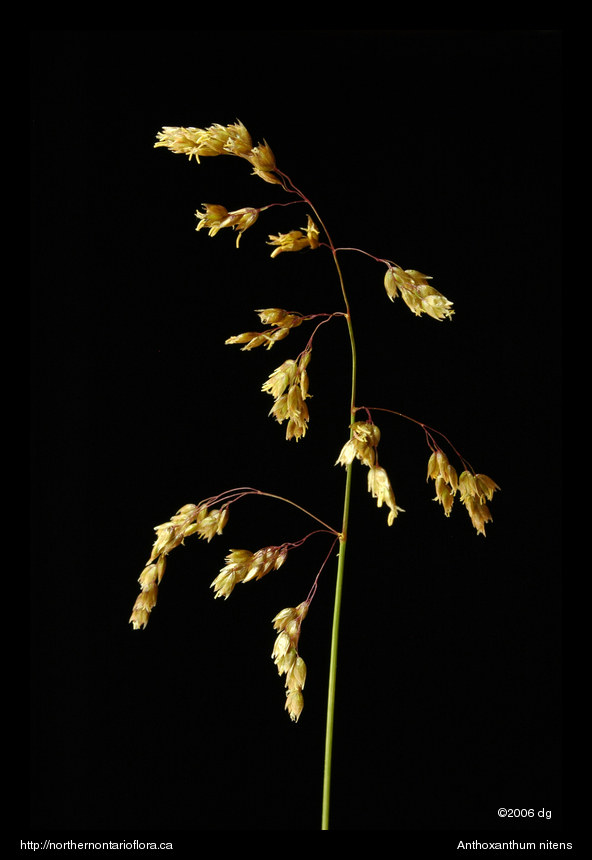
|
Northern Ontario Plant Database 
Plant DescriptionAnthoxanthum nitens subsp. nitens (Weber) Y.Schouten & VeldkampEn: sweetgrass, vanilla sweetgrass, common sweetgrass, vanilla grass
Poaceae (Grass Family) Synonymy: Until recently, sweetgrass was known as Hierochloë odorata (L.) P. Beauv. Sweetgrass was renamed Anthoxanthum nitens when the genus Hieorochloë was merged with Anthoxanthum in 1985, a change now adopted by the Flora of North America (Vol. 24, in press). The previous existence of another Anthoxanthum species with the 'odoratum' specific epithet, A. odoratum (sweet vernal grass), necessitated the change to a completely different name. General: A fragrant, perennial grass, erect, to 60 cm tall, spreading by slender creeping rhizomes. Flowering stems (culms) round and hollow, characteristic of all grasses. The genus name originates from the Greek "hieros" meaning sacred, and "chloe" meaning grass. Leaves: Fertile shoots with 2 or 3 cauline, sheathing leaves with short, lanceolate blades, ligules 1–2 mm long; sterile plants with scabrous, basal leaves, to 40 cm long. Inflorescence: An open, pyramidal panicle, to 14 cm long. Flowering stems wither soon after fruits are mature. Spikelets: 3- flowered, 4–8 mm long; glumes ovate, purplish-brown or bronze, shiny; the terminal floret bisexual, bearing 2 stamens, the lemma hairy toward the apex, smaller than the glumes; lateral florets staminate, bearing 3 stamens; lemmas of the lateral florets ciliate along the margins, awnless, as long as the glumes. Flowering in last summer. Fruits: A caryopsis. Habitat and Range: Moist to wet meadows, grassy fields, riverbanks, and lakeshores, also brackish swales along the James Bay and Hudson Bay coasts. Sweetgrass has a circumboreal range and occurs throughout Ontario. Internet Links: Details of the spikelets of Anthoxanthum nitens can be seen in this webpage from the Grasses of Iowa website. This article on the traditional uses of sweetgrass was written by Holly Wilmer for the Fall 2000 edition of Mazina'igan, the quarterly newsletter of the Lake Superior Ojibwe. This distribution map of sweetgrass is from the Grass Manual on the Web. Similar Species: Anthoxanthum odorataum – written by Derek Goertz and Susan J. Meades Back to species list |
||||||||||||||||||||||










